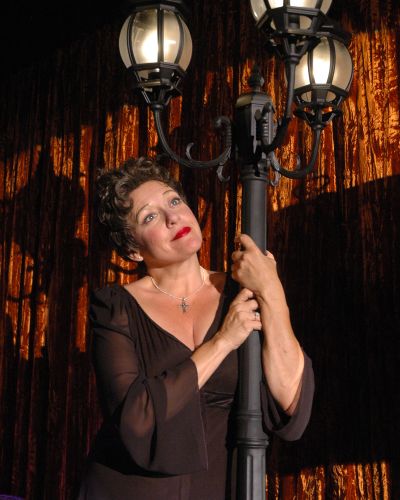Performing Piaf
Alex Ryer tells the story of the ‘waif sparrow’ in a show that mixes monologue, music

Edith Piaf, at the time of her death in 1963, was easily as popular worldwide as, say, Doris Day or Rosemary Clooney.
Yet she was no sweet “little sparrow,” which is what “piaf” means in French.
“Her songs about death, drugs, sex, etc., make the most degenerate rock songs of today sound like nursery rhymes, because there was no self-pity,” says the “Penguin Encyclopedia of Popular Music.”
“Her husky, powerful, slightly melancholy voice, emotionally naked delivery, identification with her audience, made her the best-loved singer in France.”
And now, the “waif sparrow” arrives at the Martin Woldson Theater at the Fox on Thursday, in the person of Alex Ryer.
Ryer has put together a one-woman show called “Pure Piaf,” which tells Piaf’s life story through music and monologue. She describes it as “a play with music.”
“Her life story is almost stranger than fiction,” said Ryer, by phone from her home near Fort Collins, Colo.
Consider that:
• Piaf claimed to have been born under a Paris streetlamp.
• Her mother was a cafe singer and her father was a circus acrobat.
• She spent several years growing up in her grandmother’s brothel.
• She lost her sight as a child, and had a miracle cure at age 7 after making a pilgrimage to the shrine of Sainte Therese.
• She lived on the streets with her father and was “discovered” singing on a corner by a cafe owner.
• The cafe owner was later murdered and Piaf was accused of being an accessory – but never charged.
“She had been through a lot of loss and lot of pain,” said Ryer. “She didn’t hide behind any of that. Her music was very simple and very powerful.”
Ryer uses some of Piaf’s own words, from her autobiography, to tell the story. Mainly, she uses Piaf’s music, a particularly French combination of street, cabaret and popular tunes.
“Her music, her life and her soul were inseparable,” said Ryer.
Today, Piaf is riding a worldwide resurgence, thanks to “Saving Private Ryan,” which used two of her songs to heartbreaking effect before the film’s final battle; and to “La Vie en Rose,” the 2007 French film biography. It won two Oscars this year, including Best Actress for Marion Cotillard, who played Piaf.
Piaf went through a similar resurgence during her own lifetime, when she came to America in 1946 to play a New York club date. She had been a star in France since 1936 – her music provided a mournful soundtrack to World War II – yet she was still relatively unknown in the United States.
“She booked herself into the Club Versailles for two weeks to see how it would go,” said Ryer. “She ended up staying for two years.”
Ryer chose to begin “Pure Piaf” at this turning point in Piaf’s career. It was the first time she had sung in English and the first time she had attempted to win an American audience.
“Suddenly, people could appreciate her for her talents,” said Ryer. “She was very much like Judy Garland – very tiny, but with this big voice, and she sang right from her heart. Every note she sang was emotionally charged.”
Ryer knew little about Piaf when she was asked to sing at a Bastille Day celebration a few years ago. The promoter suggested she try some Piaf. The audience loved it.
So she later put together a set of Piaf songs, which was very well received – though she did not try to imitate Piaf’s distinctive, throaty vibrato.
“Our sound is different enough that I’m never going to be a dead ringer for Edith Piaf,” said Ryer. “But I think I have captured some of the heart.”
She then put together a one-woman show of the Piaf story, which she premiered in 2005. It was performed in a Denver cabaret and then moved to the New Denver Civic Theatre. She hopes to do a workshop version soon in New York.
Ryer sings 18 songs, accompanied by a five-person combo, which includes (bien sûr!) an accordion or two.